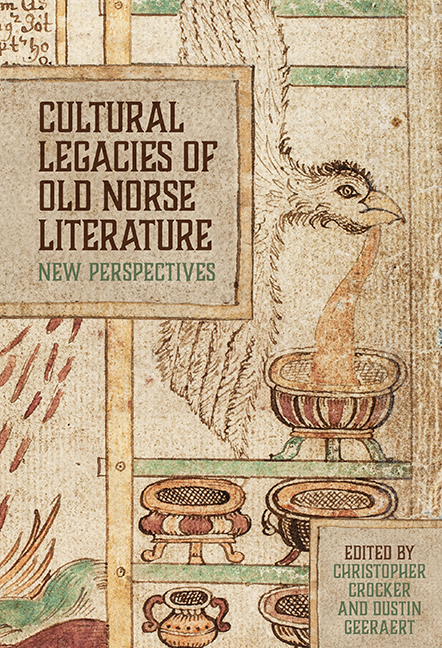Book contents
- Frontmatter
- Contents
- List of Illustrations
- List of Contributors
- Foreword: Old Norse and the Porous Boundaries of Medievalism
- Acknowledgements
- Note on the Text
- Introduction
- 1 Dr Jekyll and Mr Hyde in Medieval Iceland: Saga Realism and the Sworn Brothers
- 2 The Malleability of the Past: Íslendingabók as Narrative History
- 3 Women’s Work and Material Culture in Medieval Iceland: Gender, Narrative, and Cloth Production
- 4 Vafþrúðnismál, from Parchment to Print: Stability and Change in the Transmission of Eddic Poetry
- 5 The Odinic Motif: The Wanderer in the Mist
- 6 What has Darwin to do with Óðinn? Shapeshifting, God, and Nature in the ‘Great Story of the North’
- 7 Madness, Mythology, and Mitteleuropa: Günter Grass’s Transformation of Old Norse Myth in The Tin Drum
- 8 Once More, with Fiction: Transforming Myth in Gerður Kristný’s Blóðhófnir and the Eddic Poem Skírnismál
- Afterword: Ethnographic Medievalisms
- Bibliography
- Index
2 - The Malleability of the Past: Íslendingabók as Narrative History
Published online by Cambridge University Press: 08 October 2022
- Frontmatter
- Contents
- List of Illustrations
- List of Contributors
- Foreword: Old Norse and the Porous Boundaries of Medievalism
- Acknowledgements
- Note on the Text
- Introduction
- 1 Dr Jekyll and Mr Hyde in Medieval Iceland: Saga Realism and the Sworn Brothers
- 2 The Malleability of the Past: Íslendingabók as Narrative History
- 3 Women’s Work and Material Culture in Medieval Iceland: Gender, Narrative, and Cloth Production
- 4 Vafþrúðnismál, from Parchment to Print: Stability and Change in the Transmission of Eddic Poetry
- 5 The Odinic Motif: The Wanderer in the Mist
- 6 What has Darwin to do with Óðinn? Shapeshifting, God, and Nature in the ‘Great Story of the North’
- 7 Madness, Mythology, and Mitteleuropa: Günter Grass’s Transformation of Old Norse Myth in The Tin Drum
- 8 Once More, with Fiction: Transforming Myth in Gerður Kristný’s Blóðhófnir and the Eddic Poem Skírnismál
- Afterword: Ethnographic Medievalisms
- Bibliography
- Index
Summary
Íslendingabók ( Book of Icelanders) is a concise history of Iceland from its settlement, c. 870, to the year 1118, which was written by the priest Ari Þorgilsson inn fróði (‘the Wise’, 1067/68–1148) between the years 1122–33. The work has always been regarded as a unique source for early Icelandic history, both because of its proximity to the events described, and because of the author's preoccupation with the reliability of his sources. This view flourished particularly during the nineteenth and twentieth centuries and is still common today. However, some scholars have recently advanced the idea that there is a strongly narrative character to the work, which should also be considered.
In the nineteenth and twentieth century, Iceland struggled for independence from the Kingdom of Denmark. During this time, nationalist ambitions merged with ethnic sensibilities, and the growing need of national self-definition inspired a renewed interest in historical and native subjects, though at times an uncritical one. The Middle Ages, the early Icelandic historical period in particular, came to be regarded as an epoch encompassing distinctly Icelandic qualities, especially from a cultural point of view, but also from a political one, expressed by the people's self-proclaimed ethnicity in opposition to the Norwegian crown. By some, this period was even considered the golden age of Icelandic society (gullöld Íslendinga). Therefore, it is not surprising that a work such as Íslendingabók was particularly treasured within this context, as it well satisfied nationalist criteria. Clearly, this implies that it was regarded as a reliable historical source, a tendency that crystallized during the second half of the twentieth century, especially within scholarly discussion of early Icelandic history. Jón Jóhannesson, for example, relied heavily on Íslendingabók in his work on early Icelandic history (Íslendinga saga I, 1956), and Jakob Benediktsson, in the prologue to his influential Íslenzk fornrit edition of the text (1968), placed particular emphasis on the alleged reliability of the work as a historical source, while focusing on its chronology and on the author's sources.
- Type
- Chapter
- Information
- Cultural Legacies of Old Norse LiteratureNew Perspectives, pp. 25 - 45Publisher: Boydell & BrewerPrint publication year: 2022



